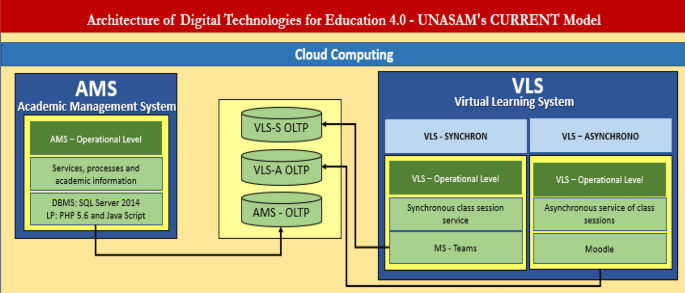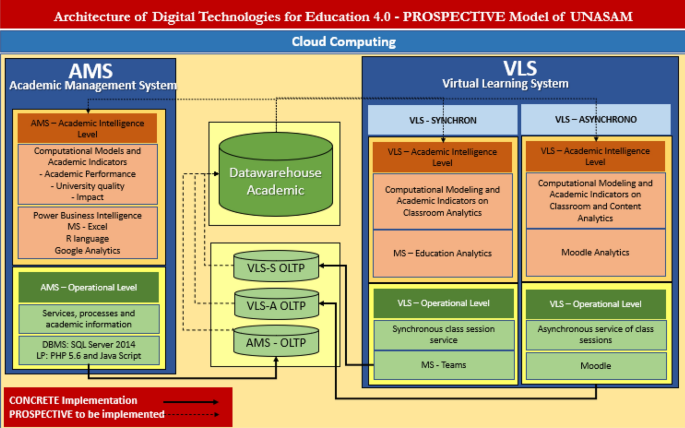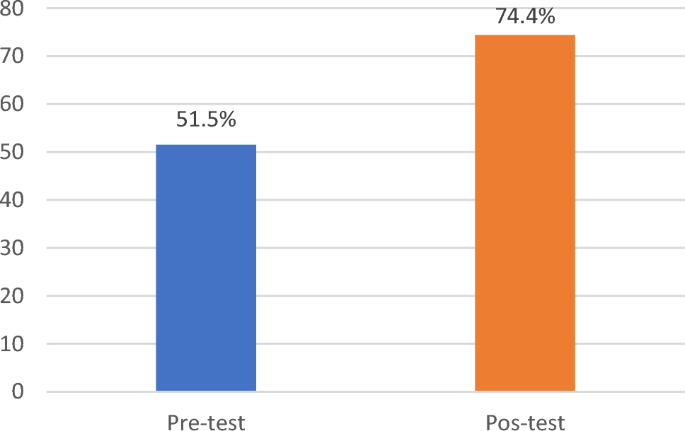Academic model 4.0 proposed for Unasam
The Fourth Industrial Revolution represents a fundamental change in the way we live and work11. In this scenario, the strategies and implementation of Education 4.0 need to be considered. Based on this, the intersection of artificial intelligence, big data, constant connectivity and robotics has been proposed to completely transform teaching, assessment and learning management12.
In this synergistic theoretical framework of topics such as the Industrial Revolution 4.0, Education 4.0 and digital technologies, the model of Education 4.0—Unasam is proposed as a model of reinvention of university teacher competencies facilitated by the strategy in systems and digital technologies for Education 4.0, as shown in Fig. 1.
Academic Model 4.0—UNASAM. Note IR4.0 is the framework for Education 4.0, which is the guideline for the strategy of systems and digital technologies that contribute to the reinvention of competencies of Unasam’s Teacher 4.0.
Architecture of digital technologies
Within the framework of the previous model, the architecture of digital technologies8 is designed for Education 4.0 with concrete solutions in digital systems and technologies such as: the Academic Management System (SGA) and the Virtual Learning System (SVA) implemented in the Moodle tool, detailed in Fig. 2.

Architecture of digital technologies for Education 4.0—Unasam’s CURRENT model Note In each system the business level is highlighted, the services offered, as well as the software tools that produce and store the information in the OLTP databases. Empirical model of the academic management of the General Office of Studies.
In a prospective scenario of the strategy in systems and digital technologies for Education 4.0, the prospective architecture of digital technologies for Education 4.0 of Unasam was modelled8. This architecture is at the second level of the architecture shown in Fig. 2, with the aim of facilitating and motivating the generation of knowledge in the process of reinventing the competences of the Teacher 4.0. University teachers13 will be able to equip themselves with the necessary knowledge to improve the teaching–learning process through the synergistic use of digital technologies, pedagogy and disciplinary knowledge, achieving integration and assertive communication with students. Furthermore, in this process of reinvention, it is necessary to encourage research, development and innovation in the field of big data with artificial intelligence and data science, whether in disciplinary, pedagogical or other areas supported by the curriculum. Figure 3 illustrates this process.

Architecture of digital technologies for Education 4.0—prospective model of the Unasam. Note Second floor to consolidate the Information and Knowledge Society and second floor, at the beginning of the Industrial Revolution 4.0 in Unasam.
Teacher training in the virtual learning system (VLS)
The profile of today’s teacher requires creative skills in planning, organising, designing, directing, guiding, in other words, managing all aspects of a learning experience in which disciplinary knowledge, digital technologies and the indispensable pedagogical conduit come together synergistically. The teacher’s role is to train autonomous learners who are able to learn to learn, discriminate facts, identify and develop unconventional solutions, form opinions and defend them14.
Given the need to integrate digital technologies in the classroom, it is necessary to emphasise in the teacher training process the development of a set of competences in which the following technical and technological dimensions converge, leading to the appropriation of ICT and Web 2.0, to be able to defend oneself in a technological environment and to use it for life, taking advantage of its pedagogical potential: Disciplinary, refers to the importance of teachers reflecting on their own disciplinary training and their use of ICT. Pedagogical, it implies adopting a creative and innovative pedagogical perspective, using ICT to solve everyday problems and to carry out learning assessment processes. Inquiry, research processes are considered as curricular and pedagogical components of ICT in educational institutions. Attitudinal, related to motivational and affective processes that influence planning, attitudes and roles adopted in the use of technologies in the classroom. Teacher training and digital literacy. Communicative, which addresses the importance of establishing effective and multidirectional communication between students and teachers. Evaluative, which takes into account the need to combine different forms of evaluation15.
Unasam has had this architecture of digital technologies at the level of the second floor since 2017, an architecture that has helped to achieve the institutional licence by meeting the basic quality conditions required by SUNEDU. From the aforementioned date until the declaration of the pandemic by COVID-19, an average of 17% of teachers (of the approximately 450 teachers per academic semester) used the Virtual Learning System (SVA) for their teaching sessions.
The arrival of the pandemic accelerated the development of teachers’ digital skills, as they had to plan their courses, run their classes and assess students remotely and virtually, so the training model implemented developed digital and pedagogical skills through the Virtual Learning System (VLS) for asynchronous learning.
One of the strategies applied was the management and implementation of the Digital Training and Support Workshop for the Virtual Learning System (VLS) of the National University of Santiago Antúnez de Mayolo. This workshop, which is part of the theoretical-practical component of the VLS Moodle LMS training, covered a series of topics essential for the efficient use of the system. The content of the workshop included an overview of the VAS, providing participants with a comprehensive understanding of the platform. The general configuration of materials within the VAS was taught, as well as the organisation of teaching weeks, including the input of activities and resources such as teaching materials and video lectures. Specific settings for assignments and forums were also covered, as well as the integration of quizzes as part of the learning activities. Participants were also given the opportunity to practise and train with what had been developed to ensure understanding and the ability to apply the knowledge acquired. Guidance was given on setting up other activities and resources, such as files and URL links, and time was spent reviewing and recommending work submitted by learners, including marking. Finally, the workshop concluded with a general practice of the learning environment, allowing participants to consolidate their VAS skills and knowledge.
The topics were methodically and systematically structured according to the criteria of empathy and clear and simple communication for the users. Each session had a dynamic of systematised activities structured in four moments: a. development of the topic b. practice of the topic in the laboratory of the VAS training area c. feedback and accompaniment by the Digital Technologies team of the OGE at a defined time d. achievement and product of the session’s learning, evidenced in the VAS training area. All these aspects described above have been implemented and put into production in technological components of the University’s digital technology architecture. The cloud computing service (hosting and processing in the cloud) of the service provider, the virtual learning system (VLS) through Moodle and the social network YouTube were used. All this consisted in carrying out the following steps: a. Methodological preparation of the learning session b. Elaboration and writing of the script for the video c. Recording of the video d. Editing of the video e. Quality control of the video and its content f. Production of the video on YouTube. Produce the video on YouTube. Producing the video on YouTube. Production of the video on YouTube g. Preparation of a manual that consolidates the workshop “Manual and Digital Workshop for Training and Support of the Virtual Learning System (SVA) of the National University Santiago Antúnez de Mayolo” in a systematic and orienting way. These procedures have been developed in the context of a strategic and prospective management of systems with digital technologies through managerial and professional competences (synergy between normativity, processes, pedagogy and systems with digital technologies innovated in the General Office of Studies—OGE).
From the perspective of statistical results
Reliability test
The Alternate Form Reliability Test was used in this case. This measures reliability through the correlation between the two scores over a significant period of time between the two tests. Alternate, equivalent or parallel forms of the same test are two tests that are designed to be virtually the same, so that the scores of the subjects on both are comparable item by item. For reliability testing using Pearson’s R, the closer ‘r’ is to 1, the greater the relationship between the two instruments, indicating greater reliability. After applying Pearson’s R, under the Alternate Form model, before and after the application of the stimulus (pretest and posttest), r = 0.824789581 is obtained, which is considered excellent reliability.
Normality test
It should be confirmed that the random variable is normally distributed in both groups. The Kolmogorov–Smirnov K-S test is used for large samples (> 30 individuals), or the Shapiro–Wilk test when the sample size is < 30. The normality criterion is:
-
a.
P-value = > α accept Ho = The data are from a normal distribution.
-
b.
P-value < α accept H1 = The data do not come from a normal distribution.
The P-Value was obtained = 0.003; which is < α (α = 0.05). P-value < α: Therefore; H1 = The data are not from a normal distribution is accepted.
Hypothesis validation test
This is the process of verifying the scientific knowledge of the theoretical-empirical model that needs to be corroborated from the data collected and which, by means of a statistical model, determines whether the hypothesis of the research is accepted or rejected. In the case of the present research, which is of a non-parametric, ordinal type with a longitudinal study, the test used was the Wilcoxon statistical model, applied to the research hypothesis.
Ho
The architecture of digital technologies does not improve teacher training in the VLS-Moodle of Unasam.
H1
The architecture of digital technologies improves teacher training in the VLS-Moodle of Unasam.
The statistical analysis that was performed at a significance level (alpha) α = 5% = 0.05. Taking into account the following rules:
If the obtained probability P-value ≤ α, reject Ho (H1 is accepted).
If the obtained probability P-value > α, do not reject Ho, (Ho is accepted).
P-value = 0.000 was obtained; which is < α (α = 0.05). P-value < α: Therefore; H1 = The architecture of digital technologies improves teacher training in the SVA-Moodle of Unasam is accepted.
Satisfaction with the training
We worked with a sample of 292 teachers who, with the information recorded in the pretest and posttest, collaborated with the instrument, Scale of Teacher Satisfaction with the Training in the Asynchronous Virtual Learning System of the National University Santiago Antúnez de Mayolo. The results show an improvement of 22.9% in the satisfaction with the training in the architecture of digital technologies, since in the pretest a result of 51.5% was obtained and in the posttest 74.4%. Figure 4 shows this.

Teacher satisfaction with the asynchronous virtual learning system training.

